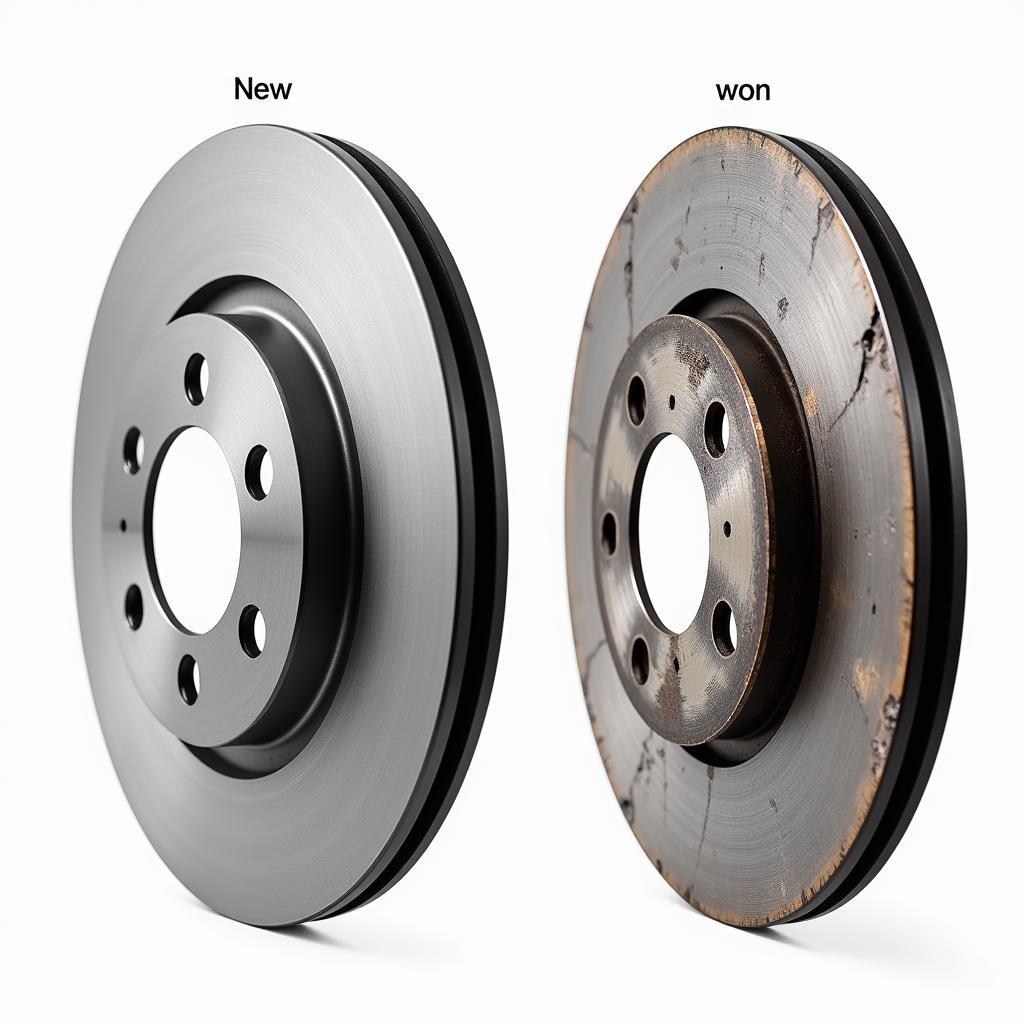If you’re seeing a warning message about your brake rotors, accompanied by alarming pictures, it can be unsettling. “Brake rotors pictures warn too far” often indicates a potential issue with your braking system that needs attention. This article will delve into the common causes, diagnostic procedures, and solutions related to this warning, empowering you to address the problem effectively.
Decoding the “Brake Rotors Pictures Warn Too Far” Message
What exactly does “brake rotors pictures warn too far” mean? This message, usually displayed on your vehicle’s dashboard or infotainment system, signifies that the brake rotor thickness has fallen below a safe threshold. The accompanying pictures usually highlight the worn areas of the rotor, providing a visual representation of the issue. This is a crucial warning, as severely worn rotors can compromise braking performance and even lead to brake failure.
Why are Brake Rotors Important?
Brake rotors are the metal discs that your brake pads clamp onto to slow or stop your vehicle. Friction between the pads and rotors generates the stopping power. Over time, this friction causes the rotors to wear down. Understanding how rotors function is key to appreciating the importance of the “brake rotors pictures warn too far” warning.
 Brake Rotor Wear Comparison
Brake Rotor Wear Comparison
Common Causes of Excessive Brake Rotor Wear
Several factors can contribute to premature brake rotor wear. Aggressive driving habits, such as frequent hard braking, can accelerate wear. Driving in hilly or mountainous terrain can also put increased stress on the braking system. Furthermore, using low-quality brake pads can exacerbate rotor wear, as they may contain abrasive materials. Sticking brake calipers can also cause uneven wear and premature rotor damage.
Diagnosing the Problem: More than Just Pictures
While the warning message and pictures provide a starting point, a proper diagnosis involves more than just visual inspection. Measuring the rotor thickness with a micrometer is essential to determine the extent of wear and whether replacement is necessary. Checking for other issues like uneven wear, warping, or cracking is also crucial. These inspections can often be done during routine brake services or by a qualified mechanic.
What to Look for During Inspection
During the inspection, pay close attention to the rotor surface. Look for any scoring, grooves, or uneven wear patterns. Also, check for any signs of overheating, such as discoloration or cracking. These indicators can point to underlying problems with the braking system.
Addressing Brake Rotor Issues: Replacement and Beyond
In most cases, excessively worn brake rotors require replacement. This involves removing the old rotors and installing new ones. It’s recommended to replace brake pads simultaneously to ensure optimal braking performance and prevent uneven wear on the new rotors. However, in some cases, rotor resurfacing may be an option, depending on the extent of wear and the rotor’s minimum thickness specifications.
Resurfacing vs. Replacement: Making the Right Choice
Resurfacing involves machining the rotor surface to remove minor imperfections and restore a smooth, even surface. However, resurfacing reduces the rotor thickness, making it more susceptible to warping and overheating in the future. Therefore, replacement is often the preferred solution, especially for severely worn rotors.
Preventing Future Problems: Proactive Brake Maintenance
Regular brake inspections and maintenance are crucial for preventing premature rotor wear. This includes checking brake pad thickness, inspecting rotors for signs of wear, and lubricating caliper slide pins. Adhering to the manufacturer’s recommended maintenance schedule can help identify and address potential issues before they escalate.
Conclusion: Don’t Ignore the Warning Signs
“Brake rotors pictures warn too far” is a serious warning that should not be ignored. Addressing the issue promptly can prevent further damage to your braking system and ensure your safety on the road. By understanding the causes of rotor wear, performing regular inspections, and seeking professional assistance when needed, you can maintain a reliable and effective braking system.
FAQ
-
How often should I check my brake rotors? It’s recommended to have your brakes inspected at least once a year or every 12,000 miles, as part of your regular vehicle maintenance.
-
Can I replace brake rotors myself? While possible, replacing brake rotors requires specialized tools and knowledge. It’s generally recommended to have a qualified mechanic perform the replacement.
-
What are the signs of warped brake rotors? Symptoms of warped rotors include pulsating brake pedal, vibration in the steering wheel, and squeaking or grinding noises during braking.
-
How much does it cost to replace brake rotors? The cost varies depending on the vehicle make and model, as well as labor rates.
-
Can I drive with worn brake rotors? Driving with severely worn rotors is dangerous and can lead to brake failure. Replace worn rotors immediately.
-
What are the best brake pads to use to prevent rotor wear? High-quality ceramic or semi-metallic brake pads are generally recommended for their durability and reduced rotor wear.
-
How can I extend the life of my brake rotors? Avoid aggressive driving habits, such as hard braking, and adhere to the manufacturer’s recommended maintenance schedule.

